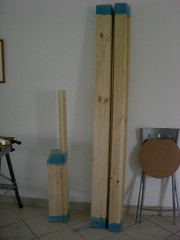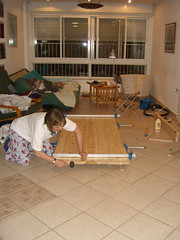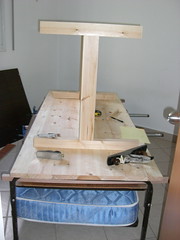
Just some drivel from a PhD student in 17th century English literature. Masoret is Hebrew for tradition; Masor is also the Hebrew word for saw. Since i hope to be learning and blogging about traditional woodworking (amongst sundry other things), i thought it was an apt play on words. Before you ask, yes, i have a glamorous social life.
Tuesday, 6 October 2009
Apartment Grey Water #4: Shabbat

Friday, 2 October 2009
Woodworking & Wittgenstein

Thursday, 1 October 2009
For TK--The Table As Promised
 My room mate at the time was kind enough to take me to the lumberyard and load up the parts, drive me back home, and unload them. Then i was on my own. The tall planks were to be laminated to form the tabletop. Just an aside: it is quite hellish to walk into a hardware store as a woman in the Middle East, and Israel is no exception. I will not go into detail (this time), but basically, you're probably better off bringing a guy friend, even if he wouldn't know a screwdriver from a hammer.
My room mate at the time was kind enough to take me to the lumberyard and load up the parts, drive me back home, and unload them. Then i was on my own. The tall planks were to be laminated to form the tabletop. Just an aside: it is quite hellish to walk into a hardware store as a woman in the Middle East, and Israel is no exception. I will not go into detail (this time), but basically, you're probably better off bringing a guy friend, even if he wouldn't know a screwdriver from a hammer.  So, though i didn't ask for this 'service' (and after convincing the guy at the lumberyard--who was rolling his eyes at me and huffing in annoyance--that i did in fact wish to laminate the top myself), he took it upon himself to create tongue and groove joints along the edges of the boards. Cheers. Klootzak. This made it more annoying to glue up and limited my choice of grain direction. Luckily, by the time i got around to that part of the project, my mother was there and she helped me. We did the job as best we could with four clamps.
So, though i didn't ask for this 'service' (and after convincing the guy at the lumberyard--who was rolling his eyes at me and huffing in annoyance--that i did in fact wish to laminate the top myself), he took it upon himself to create tongue and groove joints along the edges of the boards. Cheers. Klootzak. This made it more annoying to glue up and limited my choice of grain direction. Luckily, by the time i got around to that part of the project, my mother was there and she helped me. We did the job as best we could with four clamps.  Then, laying the table across the kitchen counter and the mustard yellow antique washing machine, we flattened (or tried to, rather. An uneven surface is just part of the charm of a handmade piece. Right?) the top with my late #5 jack plane. As for the legs, i took Matt Vanderlist's advice and made the base a trestle table. Sometimes, when they went away for extended periods of time, my room mates feared i would turn their bedrooms into a workshop. I hadn't thought of it, but it turned out to be a great idea! The bed made a perfect stand for the table top, as well!
Then, laying the table across the kitchen counter and the mustard yellow antique washing machine, we flattened (or tried to, rather. An uneven surface is just part of the charm of a handmade piece. Right?) the top with my late #5 jack plane. As for the legs, i took Matt Vanderlist's advice and made the base a trestle table. Sometimes, when they went away for extended periods of time, my room mates feared i would turn their bedrooms into a workshop. I hadn't thought of it, but it turned out to be a great idea! The bed made a perfect stand for the table top, as well!Friday, 18 September 2009
Taylor on Prayer

When you spend your days in research, with millions of ideas and tangents whirling around you, once in a while, out of the chaos, it is possible to view some order. In other words, there seems to be a divine nerd providence--you stumble upon certain things at the right time. This happens often. Sometimes it's refreshing to have the slightly different experience of stumbling on passages that are relevant to your personal life. Just as i was dreading the long hours of prayer prior to Rosh Hashanah, i happened to also be reviewing Jeremy Taylor's Holy Living (which you can read here), and i stumbled upon his section on prayer:There is no greater proof in the world of our spiritual danger than the reluctance which most people always have and all people sometimes have to pray; so weary of their length, so glad when they are done, so clever to excuse and neglect their opportunity. Yet, prayer is nothing but desiring God to give us the greatest and best things we can have and that can make us happy. It is a work so easy, so honorable, and to so great a purpose that […] God has never given us greater argument of his willingness to accept it, of His goodness and our gracelessness, of His infinite condescension and our folly, then by rewarding so easy a duty with such great blessing.
I considered myself scolded. But, like any good instructor, Taylor also explains the great benefits of prayer:Prayer is the peace of our spirit, the stillness of our thoughts, the evenness of recollection, the seat of meditation, the rest of our cares, and the calm of our tempest. Prayer is the issue of a quite mind, of untroubled thoughts. Prayer can obtain everything. It can open the windows of heaven and shut the gates of hell. It can put a holy constraint upon God and detain an angel till he leave a blessing. It can open the treasures of rain and soften the iron ribs of rocks till they melt into tears and a flowing river. Prayer can arrest the sun in the midst of its course and send the swift-winged winds upon our errand. All those strange things, secret decrees and unrevealed transactions which are of heaven, shall combine in ministry and advantages for the praying man.And, for the more practical minded, within the section on prayer is a sub-section entitled 'Remedies Against Wandering Thoughts in Prayer.'
Sunday, 6 September 2009
Karate Kidding?!
- 13 blocks of concrete were used as a test case
- The sledgehammer delivered 709 lbs. of force, breaking 8/13 blocks
- The elbow broke all of the blocks, delivering 2000 lbs. of force (triple the sledgehammer)
- 1000 Gs of acceleration at impact, with a speed of 21 m.p.h
Thursday, 3 September 2009
William Holman Hunt: The Shadow of Death
has been hard at work all the day, and the setting sun tells Him the hour for cessation from toil has arrived, that his day's labour is over. He has just risen from the plank on which He has been working, and is portrayed as throwing up His arms to realise that pleasant sensation of repose and relaxation . . . and in perfect harmony with this physical act, so natural and grateful to every one, the Divine Labourer pours forth His soul in fervent gratitude to His Father that the welcome hour of rest has come. {WHH's pamphlet on the painting}
was begun in Jerusalem in April 1870. The figures of Christ and the Virgin were painted out of doors, the models posing on the roof of Hunt's house in the Muslim quarter. Two movable huts were constructed in an attempt to regulate the light, since the artist was determined to capture faithfully the impression of the setting afternoon sun. This was a heroic but virtually impossible task on such a large canvas and involved Hunt in continual reworking of both versions. They were completed after his return to London in July 1872, and in March 1873 were sold to Agnews for 10,000 guineas. The large canvas, which was on view at their Bond Street gallery from December 1873 to August 1874, was described that May in an American periodical as 'probably the most talked-about painting in the world' ('Holman Hunt and his "Shadow of death"', 657). {ODNB}
Scripturally, the subject is "the Shadow of Death," — the bearing of the first burden of the Curse of Adam. Morally, it is this also: the bestowing of Life in trust for future universal good, rather than for immediate personal joy. Surely there are enough of every class who have felt the burdensomness of toil, the relief at his cessation; and also enough of those who have battled against the temptation to seek this world's glory at the expense of their peace with the silent Father, and who may be encouraged to persevere. [Mr. Holman Hunt's Picture, "The Shadow of Death" (London: Thomas Agnew: [1873]), p. 2.]
Among the men I know, or have known, he is the One (literal) Christian, of intellectual power. I have known many Christians-many men of capacity: only Hunt who is both, and who is sincerely endeavouring to represent to our eyes the things which the eyes were blessed which saw. (1874)
The depiction of the Saviour and Virgin in the interior of a carpenter's workshop was influenced by Ruskin, who in the third volume of Modern Painters (1856) had called for a sacred art 'representing events historically recorded, with solemn effort at a sincere and unartificial conception' (Works, 5.85). Hunt's reading of Ernest Renan'sVie de Jesus (1863) in 1869 encouraged him to depict the Saviour as a working man, an image that he was well aware would appeal to a wide audience. Indeed, the engraving published in 1878 was Agnews' most widely circulated nineteenth-century print. But by imbuing his picture with typological symbolism Hunt wanted to convey to his audience the spiritual as well as archaeological aspects of his subject.
The course of events seem so much more comprehensible-the journeys of the Saviour, in the last days of his ministration, from Bethany to Jerusalem to the Temple around the Mount of Olives ... seem so real as to appear like an event of the day. (Pre-Raphaelite Friendship, 45)
the vagueness of the description in the Talmud: of the form in which the scarlet was placed on the head I feel it to be very much left to myself. So I merely placed it round about the horns — to suggest the crown of thorns.Properly speaking, the red headband in The Shadow of Death provides a type of the Crown of Thorns, while in a somewhat looser manner it recapitulates the scarlet wool born by the representative of Israel's sins, fulfilling that type in part. Of course, both types are only completed by the Crown of Thorns itself. This device recapitulates Hunt's earlier attempt at creating a prefigurative image of the Passion in The Scapegoat, for he now attempts such symbolism in a subject more accessible to his audience. {Replete with Meaning: William Holman-Hunt and Typological Symbolism, by George P. Landow, on the Victorian Web, click here}
You'll probably never look at your woodworking tools the same way again. According to the pamphlet,
The shadow of the wearied Lord falling on the rack which holds the carpenter's tools, with the mandrel placed vertically in the centre, at once literally realises the form of a cross, and the hands falling thereon suggest the idea of a figure nailed thereupon, and thus the particular death Our Lord would die.
Furthermore, the tools become types of those used to torture Christ, while the reeds standing in the corner of the shop similarly prefigure the mock scepter thrust upon him during his torments. Standing in a plank which Christ has been cutting, a saw casts a shadow upon the wall that clearly provides a prefiguration of the spear that pierced his side.
Christ's girded loins also suggest the costume of the Crucifixion, while the plumb-bob dangling from the rack of tools suggests Christ's heart, because of its shape and placement within the shadow. {Landow, Victorian Web. Read the rest of it--it's awesome--click here}


